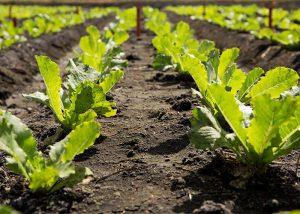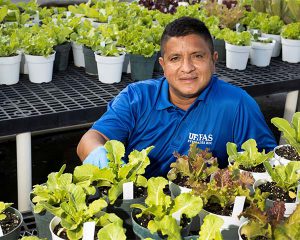Belle Glade, Florida, USA
May 22, 2020
Lettuce is one of the top ten vegetables cultivated in the United States and for good reason. Romaine, iceberg, leaf and butterhead types of lettuce are staples in refrigerators around the world. Used as a basis for salads, as a topping for burgers and sandwiches, as a bread substitute for wraps, and even as a garnish for elegantly plated cuisines, lettuce serves as a recommended source of extra nutrition, much-needed fiber, and fewer added calories to diets.

Rows of research lettuce at the UF/IFAS Everglades Research and Education Center in Belle Glade.
But the crop has experienced devastation nationwide with the emergence of the deadly Bacterial Leaf Spot (BLS), a disease caused by a pathogen known as Xanthomonas campestris pv. vitians (Xcv). This unpredictable disease can cause severe economic losses devastated entire harvests. Currently, there is no meaningful control method.
University of Florida scientists at Everglades Research and Education Center in Belle Glade, along with other land grant universities and federal agencies, have been at the forefront of research since the disease emerged. Focus has been on studying BLS and how it destroys lettuce.
Now an $850,816 grant will fund the continuation of research led by UF/IFAS scientists in a multistate endeavor with Pennsylvania State University and the United States Department of Agriculture – Agricultural Research Services (USDA-ARS) Salinas, CA. The grant, managed by the Florida Department of Agriculture and Consumer Service (FDACS) through the Specialty Crop Multi State Program of the USDA-AMS to UF/IFAS, is designated for the study of disease resistance in lettuce, to boost cultivar variations that are BLS-resistant through breeding and genetics, and to research BLS-lettuce interaction.

German Sandoya amongst plant samples at the Everglades Research and Education Center.
Germán V. Sandoya-Miranda, assistant professor of lettuce breeding and genetics at Everglades Research and Education Center, overseeing the project as principal investigator, has been researching BLS since 2016.
Sandoya is joined by UF’s Calvin Odero, UF/IFAS associate professor of agronomy specializing in weed science as co-lead, UF/IFAS Extension Palm Beach staff, Pennsylvania State University’s Carolee Bull, a professor and department head of Department of Plant Pathology, Maria Gorgo-Gourovitch, an Extension educator and Plant Pathology affiliate instructor at Pennsylvania State University, and lettuce plant breeder and geneticist Ivan Simko of the USDA-ARS in California.
“This is the first time that experts in plant breeding, genetics, bacteriology, and weed science partner to develop sustainable and long-term solutions to battle an unpredictable and devastating disease in lettuce”, said Sandoya. “I have intentionally brought together the leading experts representing the strongest possible group to work on this disease for a variety of geographic impacted areas and assorted farm-size growers.”
The United States is the second-largest producer of lettuce in the world. Harvested on more than 342,965 acres across the nation, it represents a $2 billion industry mostly situated in California, Arizona, and Florida, according to the 2017 U. S. Department of Agriculture (USDA) Census Data. Lettuce is also an important component of sales for small diversified farms in the Mid-Atlantic and everywhere else nationally. In Florida, more than 9,300 acres harvest lettuce throughout the state between September and May, with a majority of the production occurring in the Everglades Agricultural Area located just below Lake Okeechobee in Palm Beach County.
“In this project, we are using plant breeding and genetic approaches to study disease resistance and the various interactions between the lettuce and the pathogen,” Sandoya added. “For the growers, we will develop resistant cultivars, because of the warmer conditions in the state that make growing in Florida more complicated.
Another objective in the research will examine the potential of weeds as a secondary cause of the disease in Florida, he added.
Emma Rosenthal, a graduate student working with Bull, is interested in understanding the specificity of the plant-pathogen interactions. She is hoping to use genes involved in specificity to develop methods for detection and quantification of strains of the pathogen causing disease on different varieties.
Gorgo-Gourovitch will also ensure that knowledge from this project is disseminated as bilingual extension products in keeping with Penn State’s Latinx Agriculture initiatives.
USDA-ARS will be involved in identifying resistance genes in cultivated and wild accessions of lettuce and introduce these genes into the breeding program.